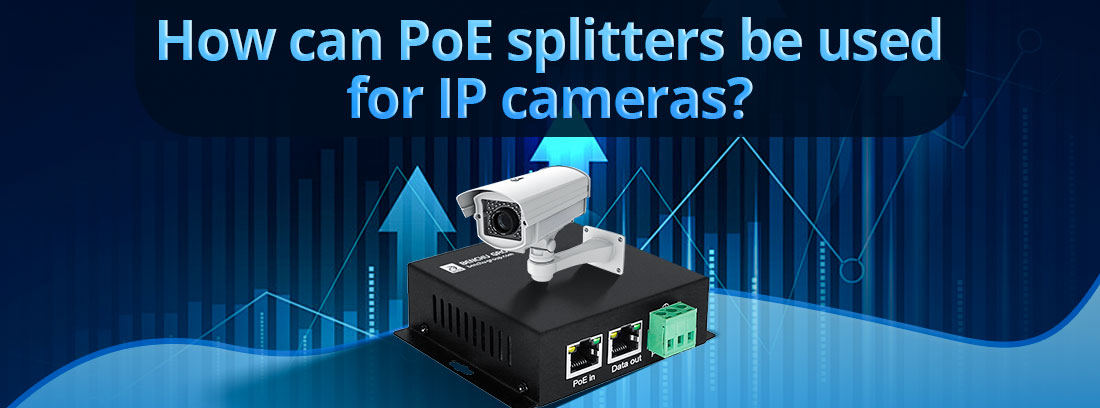
يعد استخدام القوة على Ethernet (POE) لكاميرات IP حلاً عمليًا لتشغيل الكاميرات التي لا تدعم POE أصلاً ولكنها لا تزال بحاجة إلى التوصيل بالشبكة. يتيح لك Splitter Poe توصيل كل من الطاقة والبيانات عبر كابل Ethernet واحد إلى كاميرات IP غير بوي ، وتبسيط التثبيت وتقليل فوضى الكابل. في هنا وصف مفصل خطوة بخطوة لكيفية استخدام Poe Splitters لكاميرات IP:
1. حاقن بو أو مفتاح بوي
لتشغيل كاميرات IP الخاصة بك باستخدام POE ، تحتاج إلى حاقن POE أو مفتاح POE الذي يدعم. هذه الأجهزة مسؤولة عن توفير كل من الطاقة والبيانات عبر كابل Ethernet واحد.
--- حاقن بو: يتم إدخال هذا الجهاز بين كابل الإيثرنت والمفتاح ، ويحقق الطاقة في الكبل مع البيانات. هذا مفيد بشكل خاص إذا لم يكن مفتاحك يدعم POE.
--- التبديل الذي يدعم POE: إذا كنت تستخدم مفتاحًا مدعومًا ، فإن كبل Ethernet من المفتاح سيحمل كل من البيانات وطاقة الكاميرا.
2. بوي فاصل
يتم توصيل خائن Poe في نهاية كاميرا كابل Ethernet. وظيفة الفاصل هي:
--- منفصل القوة والبيانات: يفصل الطاقة (عادة 48 فولت) عن البيانات (إشارة Ethernet).
--- قم بتحويل الطاقة إلى جهد الكاميرا: يقوم الفاصل بعد ذلك بتحويل الطاقة 48 فولت إلى الجهد المناسب المطلوب من قبل الكاميرا (عادةً 5 فولت أو 9 فولت أو 12 فولت أو 24 فولت وفقًا لطراز الكاميرا).
--- تمرير بيانات Ethernet: يمرر بيانات Ethernet مباشرة إلى الكاميرا لاتصالات الشبكة.
عادةً ما يكون لدى الخائن مخرجان:
--- إخراج الطاقة: هذا عادة ما يكون مقبس برميل DC أو منفذ Micro-USB ، اعتمادًا على متطلبات إدخال الطاقة للكاميرا.
--- إخراج البيانات: هذا منفذ Ethernet يمرر البيانات (إشارة الشبكة) إلى كاميرا IP.
3. توصيل المكونات
عملية توصيل أ بوي فاصل يتضمن كاميرا IP هذه الخطوات:
قم بتوصيل كابل Ethernet بحقن Poe أو مفتاح Poe الذي يدعم:
--- إذا كان استخدام حاقن POE ، قم بتوصيل أحد طرفي كابل Ethernet بالحاقن والطرف الآخر إلى مفتاح الشبكة أو جهاز التوجيه.
--- إذا كنت تستخدم مفتاح POE الممكّن ، ما عليك سوى توصيل كابل Ethernet من المفتاح إلى Poe Flitter.
Poe Splitter to IP Camera:
--- قم بتوصيل الطرف الآخر من كابل Ethernet (من حاقن Poe أو التبديل) إلى إدخال Ethernet الخاص بـ Poe Splitter.
--- سيفصل الخائن البيانات والقوة.
إخراج الطاقة إلى كاميرا IP:
--- قم بتوصيل إخراج الطاقة من Poe Splitter (عادةً ما يكون مقبس برميل DC) بإدخال الطاقة لكاميرا IP.
--- يجب أن يتطابق جهد الإخراج مع الجهد المطلوب للكاميرا. على سبيل المثال ، إذا كانت الكاميرا تتطلب 12 فولت DC ، فتأكد من إخراج الفاصل 12 فولت.
إخراج البيانات إلى كاميرا IP:
--- قم بتوصيل إخراج البيانات من Poe Splitter (والذي سيكون منفذ Ethernet) مباشرة بمنفذ Ethernet على كاميرا IP.
4. مزايا استخدام Poe Splitters لكاميرات IP
--- الأسلاك المبسطة: بدلاً من تشغيل كبلات منفصلة للسلطة والكاميرا إلى كاميرا IP الخاصة بك ، يتيح لك Poe استخدام كبل Ethernet واحد لكل من الطاقة والبيانات.
--- المرونة: تمكنك Poe Splitters من استخدام البنية التحتية القياسية لـ Ethernet (مثل كابلات CAT5E أو CAT6) إلى كاميرات الطاقة التي لا تتم تمكين POE.
--- وفورات التكاليف: يمكن أن يؤدي استخدام POE إلى تقليل التكلفة الإجمالية للتثبيت عن طريق التخلص من الحاجة إلى تثبيت كابل طاقة منفصل. هذا مفيد بشكل خاص عندما يتم تثبيت الكاميرات في مواقع يصعب الوصول إليها أو عن بُعد حيث قد تكون كابلات الطاقة الجارية صعبة أو مكلفة.
--- إدارة الطاقة المركزية: تتيح لك حقن POE والمفاتيح التي تدعم POE عادةً إدارة الطاقة مركزيًا. إذا كان لديك كاميرات متعددة ، فيمكنك تشغيلها جميعًا من مفتاح Poe أو حاقن واحد ، مما يؤدي إلى تبسيط النظام.
5. اعتبارات رئيسية
--- توافق الجهد: تأكد من أن فاصل POE قادر على توفير جهد الإخراج الصحيح للكاميرا الخاصة بك. تحقق من متطلبات الطاقة الخاصة بكاميرا IP (المدرجة عادة في مواصفات الكاميرا) واختر فاصل Poe الذي يتطابق.
--- ميزانية الطاقة: تأكد من أن Poe Injector أو Poe Switch الذي تستخدمه لديه طاقة كافية لدعم جميع الأجهزة المتصلة. يوفر Standard Poe (IEEE 802.3AF) ما يصل إلى 15.4W لكل منفذ ، في حين أن POE+ (IEEE 802.3AT) يمكن أن يوفر ما يصل إلى 25.5W لكل منفذ. يمكن أن توفر بعض الأنظمة الراقية (IEEE 802.3BT أو POE ++) ما يصل إلى 60 واط أو حتى 100 واط ، وهو ما قد يكون مطلوبًا للأجهزة المتعطشة للطاقة.
--- قيود المسافة: يبلغ الحد الأقصى للمدى لتقديم الطاقة عبر Ethernet حوالي 100 متر (328 قدمًا) لكابلات Ethernet القياسية. إذا كانت الكاميرا موجودة أبعد من ذلك ، فقد تحتاج إلى التفكير في استخدام موسع POE أو معيار POE أعلى من الطاقة (مثل IEEE 802.3BT).
مثال الإعداد:
1. Poe Injector أو Switch-Conability: يقوم هذا الجهاز بحقن الطاقة والبيانات في كابل Ethernet.
2. كابل Ethernet: يحمل كل من الطاقة والبيانات من مصدر POE إلى الكاميرا.
3. Poe Splitter: يفصل الطاقة والبيانات في نهاية الكاميرا ، وتحويل الطاقة إلى الجهد المطلوب للكاميرا.
4. كاميرا IP: تعمل بالشبكة والشبكة من خلال كابل Ethernet ، دون الحاجة إلى خط طاقة منفصل.
باستخدام فاصل POE ، يمكنك تشغيل كاميرات IP غير بوي بكفاءة بدون كابلات إضافية للطاقة ، وتبسيط التثبيت والصيانة.